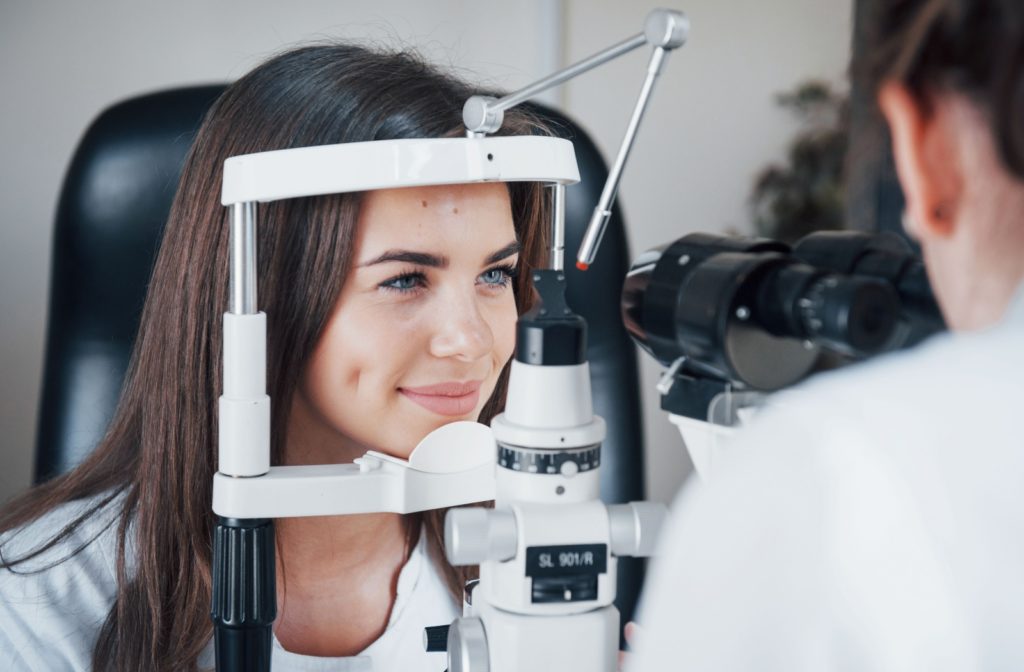When we talk about our ability to see, two terms frequently crop up–eyesight and vision. While often used interchangeably in everyday conversation, these two concepts hold distinctly different meanings within the realm of ocular health and functionality.
Understanding the difference between eyesight and vision is crucial for appreciating the complexity of our visual system and recognizing when and how to seek care or improve our visual capabilities.
Eyesight and vision represent different aspects of seeing. Eyesight is the ability to see objects and letters from a standard distance, focusing on the eye’s capability to discern details.
Vision goes beyond this, encompassing the brain’s role in processing and understanding visual information, including depth perception, color recognition, and eye coordination.
Regular eye exams at Hercules Optometric Group are part of a healthy eye care regimen to ensure clear and crisp vision.
Eyesight: The Physical Ability to See
Eyesight, also known as visual acuity, refers to the physical ability of the eyes to see objects clearly at a standard distance. It is the aspect of our vision that optometrists measure during an eye exam, typically using a Snellen chart which has progressively smaller letters.
Eyesight is fundamentally about the sharpness or clarity of vision at various distances and is influenced by the shape of your eye, the health of your eye components (like the cornea and retina), and the ability of your brain to interpret signals from your eyes.
A person who has 20/20 eyesight, indicates that they can see what an average individual can see on the chart from 20 feet away. Nonetheless, while 20/20 eyesight is an important marker of visual acuity, it is but a single element of the broader, multifaceted capability known as vision.
Vision: The Brain’s Interpretation of What We See
Vision encompasses a broader spectrum. It’s not just about how clearly we see objects but how our brain interprets and processes the information our eyes send it. Vision includes our ability to focus on objects, track movements, recognize colors, perceive depth, and understand and interact with the world visually. It’s about how we use and interpret the images coming into our eyes, not just the clarity of those images.
Problems with vision can occur even if someone has perfect eyesight. These issues might involve difficulties with eye coordination, depth perception, visual contrast sensitivity, and more. For example, someone might have trouble catching a ball (an issue with visual processing) despite being able to read the smallest letters on an eye chart (excellent eyesight).
Why Distinguishing Between Eyesight & Vision Matters
Understanding the distinction between eyesight and vision is essential for several reasons:
- Diagnosis and Treatment: Knowing whether a problem lies with your eyesight or vision can guide specialists in diagnosing issues accurately and prescribing the correct treatment or therapy. This nuanced approach ensures that individuals receive the appropriate intervention, whether it’s corrective lenses for eyesight or vision therapy to enhance the brain’s processing capabilities.
- Educational and Developmental Implications: Children might struggle in school due to undiagnosed vision problems, even if they have good eyesight. Issues like difficulty tracking text or poor hand-eye coordination can hinder learning. Vision exams are crucial for early diagnosis and intervention, which can significantly improve educational outcomes by addressing these hidden visual impairments.
- Personal Health and Safety: For adults, understanding and maintaining both good eyesight and vision is crucial for tasks such as driving, where depth perception, peripheral vision, and the ability to quickly process visual information are as important as seeing clearly. Recognizing and addressing any deficiencies in these areas can improve personal safety and reduce the risk of accidents.
The distinction between eyesight and vision has far-reaching implications across various aspects of life, underscoring the importance of comprehensive visual health care.

Enhancing Eyesight & Vision
Improving eyesight and vision goes beyond correcting blurry vision with glasses or contacts, requiring a holistic approach that includes eye health and the brain’s ability to process visuals.
Regular eye exams are an important part of spotting issues early, but enhancing vision also involves daily exercises to strengthen eye-brain connections, like focus-shifting exercises and activities that demand hand-eye coordination (e.g., sports, playing catch, video games), which improve reflexes, spatial awareness, and reaction times.
Relaxation techniques, especially the 20-20-20 rule, help prevent digital eye strain. Nutrition rich in vitamins and omega-3s, supports eye health. Wearing sunglasses also protects against UV damage. Adopting this comprehensive approach ensures not just eye health but also optimizes visual processing and quality over time.
Navigating the Spectrum of Sight:
The differences between eyesight and vision are subtle yet significant. By acknowledging and understanding these differences, we can better appreciate the complexity of our visual system and take more informed steps toward maintaining and enhancing our ocular health.
Whether it’s through regular eye exams, visual exercises, or simply being aware of the signs that something might be amiss, taking care of both our eyesight and our vision is a crucial component of our overall well-being.
We encourage you to book your next eye appointment with Hercules Optometric Group–we’re happy to be a part of your healthy vision habits.



